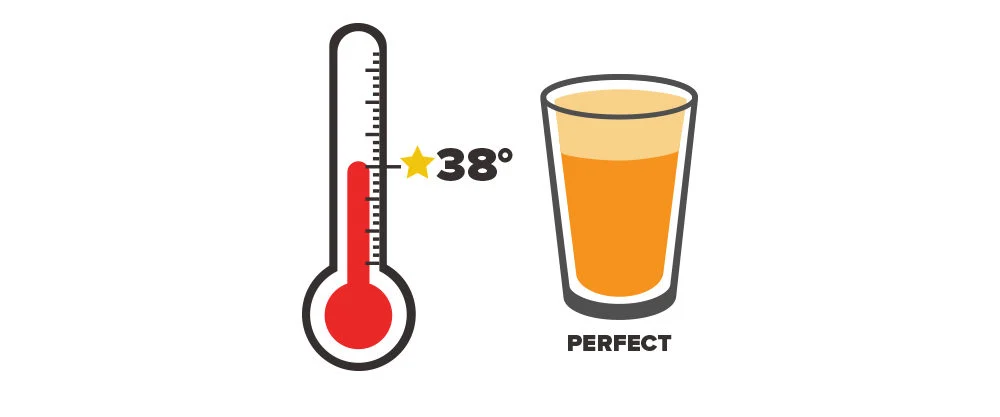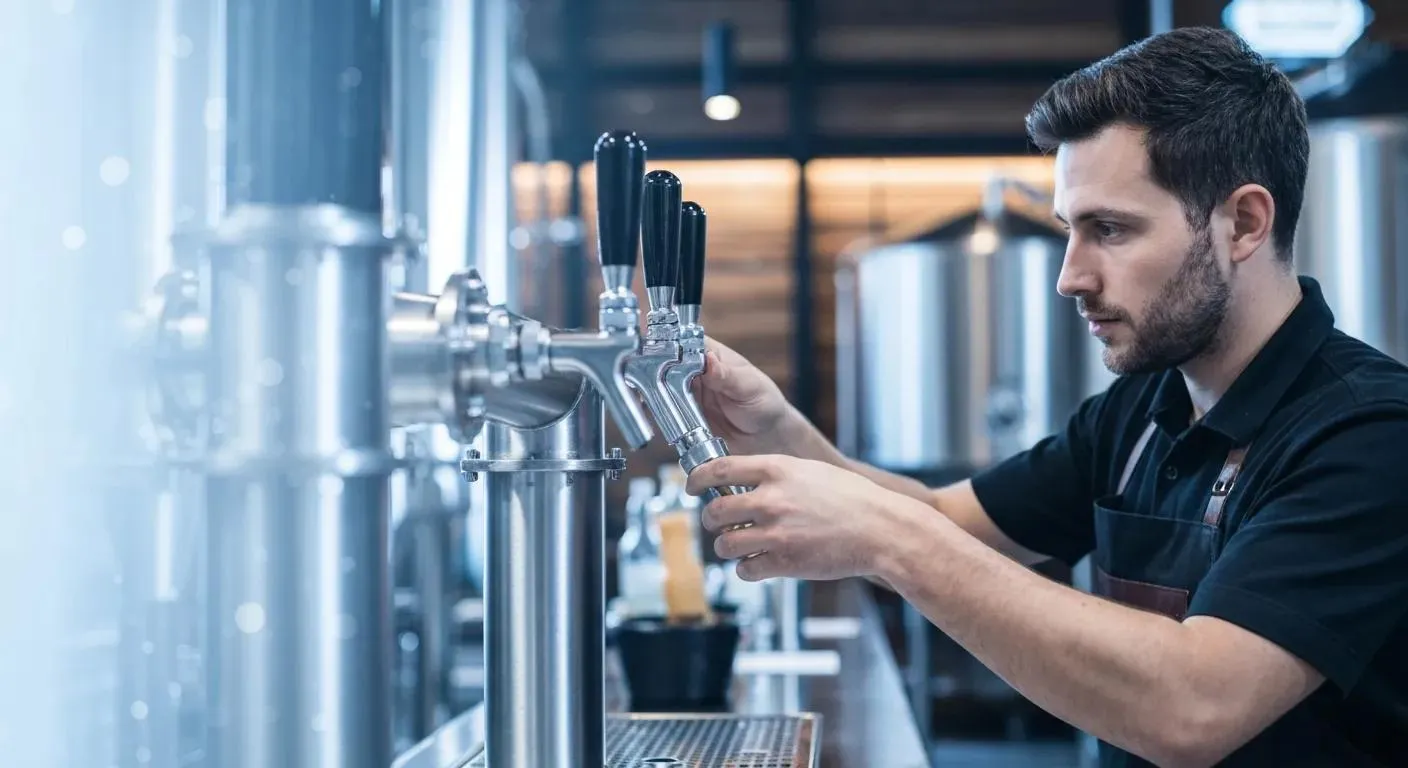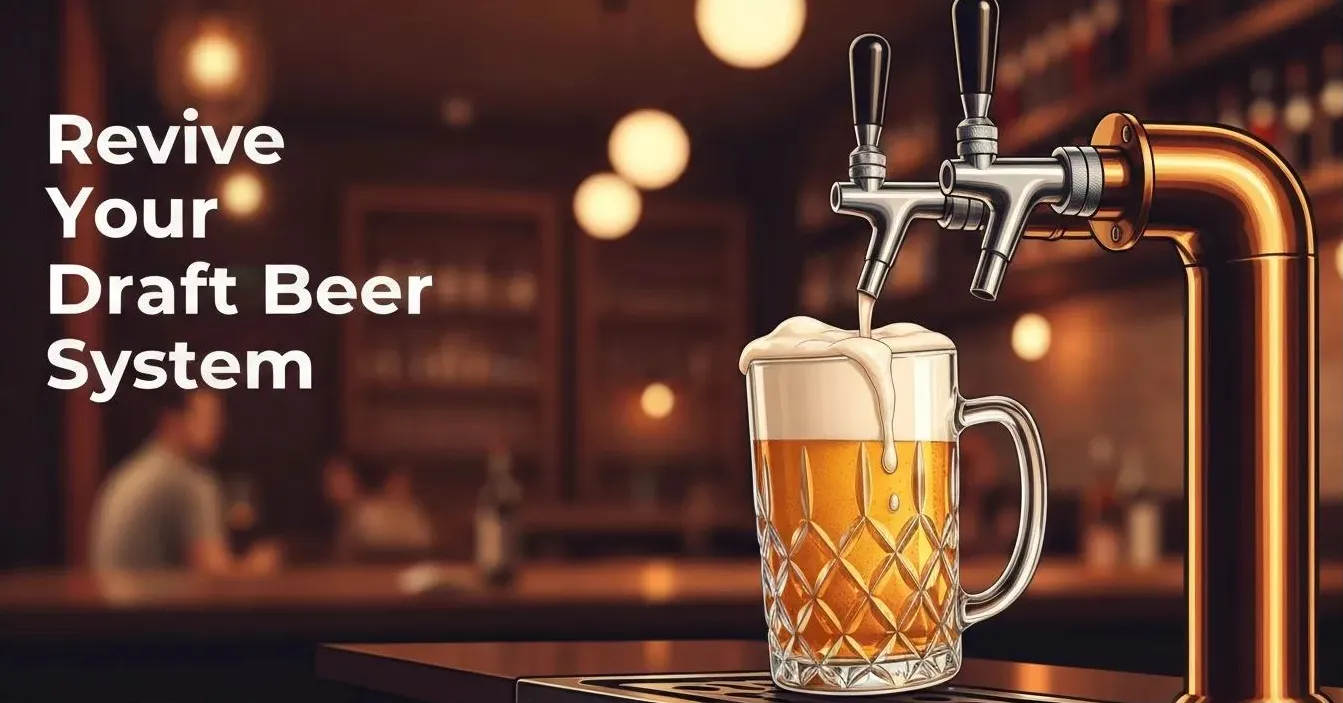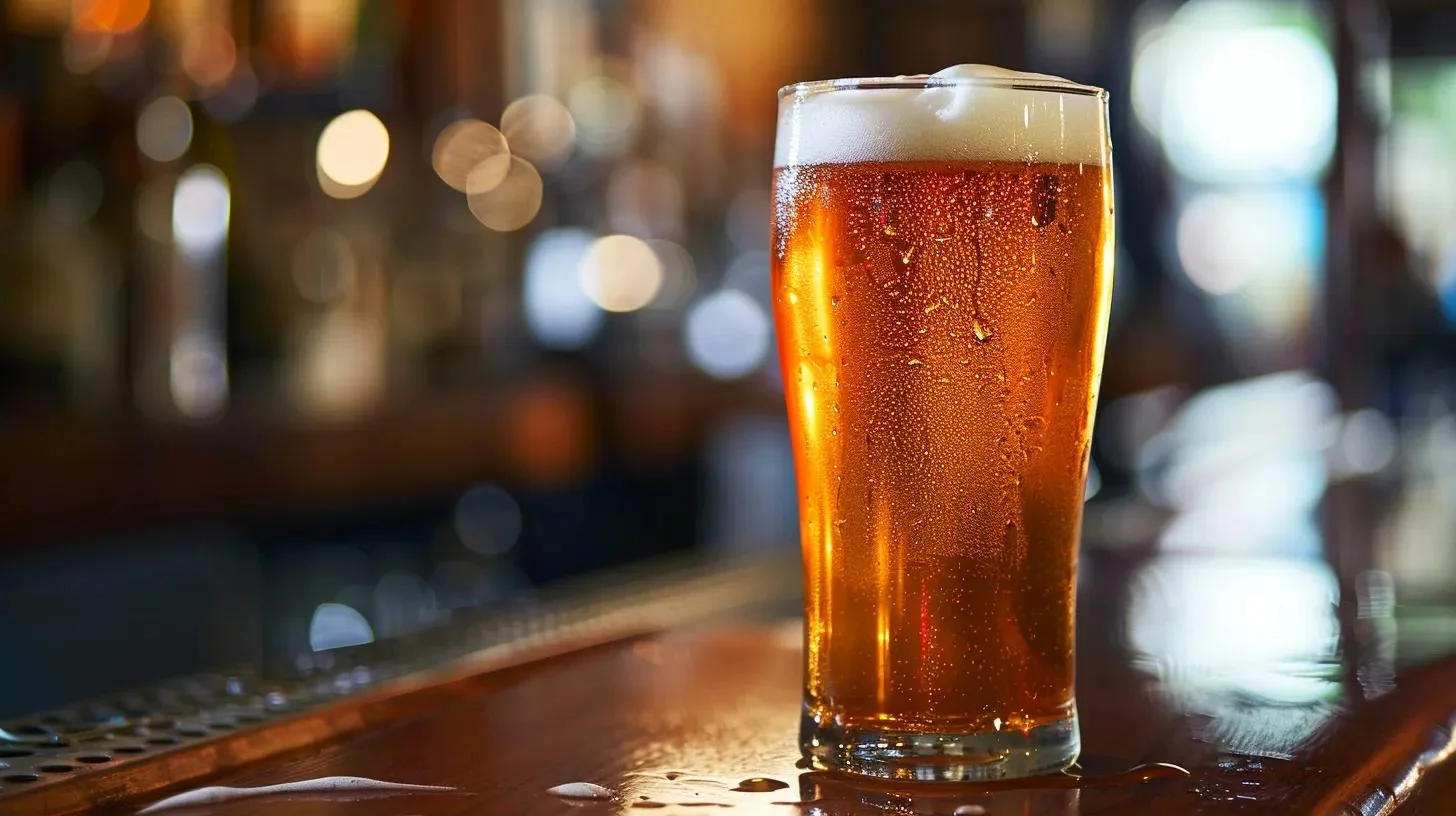Ale Serving Temperature: The Ideal Range for Perfect Draft Beer Pours

Maintaining the correct temperature for serving draft beer is crucial for preserving its quality, taste, and carbonation levels. The standard temperature for draft beer systems in the United States ranges between 36 and 38 degrees Fahrenheit, with a target temperature of 38 degrees often cited as ideal. This specific liquid temperature also helps maintain a balanced system and ensures that the beer retains the carbonation and flavor profile intended by the brewer.
Temperature control goes beyond simply setting a number on a refrigerator. The components of the draft beer system, including lines, taps, and towers, all need to be consistently maintained at the optimal temperature to prevent the beer from becoming too warm or too cold. If the beer deviates from this narrow temperature range, issues such as foaming or flatness can occur, directly impacting the serving and brewing process, presentation, and ultimately, the consumer's experience. Proper refrigeration is integral to this process, ensuring that draft beer served in bars, restaurants, and at home brings out the best possible flavor and quality.
- Serving draft beer at the right temperature is essential for optimal flavor and carbonation.
- A balanced draft beer system requires consistent temperature control.
- The quality of draft beer is significantly influenced by refrigeration and serving techniques.

Understanding Beer Temperatures
When it comes to drinking beer, temperature is more than just a number on a thermometer—it’s a key factor that can make or break your beer experience. The serving temperatures of beer play a pivotal role in how flavors and aromas are perceived. Each beer style has its own ideal serving temperature that enhances its unique characteristics, ensuring you get the most out of every sip.
For instance, serving an American Pale Ale at its optimal temperature allows its citrusy and hoppy notes to shine, while a Belgian Strong Ale served too cold might lose its complex, fruity flavors. On the other hand, a Pale Lager served too warm can taste flat and unrefreshing. Understanding these nuances helps appreciate the full spectrum of flavors different beers offer.
Serving beer at the wrong temperature can lead to a disappointing experience. Cold temperatures can mute the intricate flavors of a Belgian Pale Ale, making it taste bland. Conversely, serving a beer too warm can accentuate undesirable flavors, making it taste overly alcoholic or syrupy. Therefore, adhering to the recommended serving temperatures is essential for enjoying beer as the brewer intended.
By paying attention to the ideal serving temperatures, you can elevate your beer-drinking experience, ensuring that each pour is as flavorful and enjoyable as possible.
Optimal Serving Temperatures
The precise temperature at which a draft beer is served can significantly influence its flavor profile and mouthfeel. Belgian strong ales, for instance, are best served at warmer to unlock their complex flavors and aromas. Different styles of beer demand specific temperature ranges to ensure the best possible tasting experience.
Temperature Variations by Style: American Pale Ales
- Light Lagers & Pilsners: For beers such as light lagers and pilsners, serving them chilled between 36-38 degrees Fahrenheit enhances their crispness and refreshment quality. This is in line with the temperature of most draft beer systems.
- Pale Lagers: Pale lagers are best enjoyed at a slightly warmer temperature range of 38-40 degrees Fahrenheit. This range enhances their flavors and overall drinking experience, making them more enjoyable.
- Ales, IPAs, & Amber Beers: Ales and their variants like IPAs, amber beers, and amber lagers generally benefit from slightly warmer temperatures. A range of 40-45 degrees Fahrenheit is preferred, allowing the complexity of their flavors to shine through.
- Stouts, Porters, & Dark Lagers: These richer, darker beers are best served at even warmer temperatures, typically between 45-55 degrees Fahrenheit, which helps to release their deeper flavors and smooth mouthfeel.
- Wheat Beers & Sours: Delicate wheat beers and tart sour beers have an ideal serving temperature similar to ales, usually around 40-50 degrees Fahrenheit to balance their nuanced taste and enhance their aromatic properties.
Impact on Flavor and Mouthfeel
- The temperature of beer affects the tongue’s sensitivity to particular flavor compounds. Colder temperatures can mute some flavors while emphasizing others, such as the bitterness in a hop-forward IPA or the maltiness of a dark lager. Serving certain beers at cellar temperature (50-55°F) enhances their flavor profiles, allowing the complex notes of Belgian ales, bocks, and other full-bodied beers to be fully appreciated.
- Mouthfeel is also temperature-dependent. Stouts and porters, for example, are frequently served warmer to appreciate their creamy and smooth textures. In contrast, colder temperatures tend to enhance the carbonation and light body of beers like light lagers and pilsners, making them more refreshing. However, serving beer too cold can mask its virtues and enhance undesirable qualities such as bitterness and dryness.
- A beer that’s too cold can lose its aromatic bouquet, whereas overly warm beer may taste flat or overly alcoholic. Therefore, adhering to the optimal temperature range for each style is crucial for maximum enjoyment.
Draft Beer System Components
In a draft beer system, ensuring a consistent serving temperature and maintaining cleanliness is crucial for optimal beer quality and taste.
Maintaining Proper Temperature: Cold Temperatures
Draft beer systems rely heavily on maintaining the correct temperature to serve beer that's both refreshing and true to its intended flavor profile. A is often used in smaller setups, combining a keg, a CO2 tank, and a refrigerator to both cool and dispense beer. Larger systems may employ a walk-in cooler where multiple kegs are stored at the same temperature, an ideal temperature, typically around 38˚F. This environment is controlled by sophisticated equipment including regulators and a glycol system to manage the temperature along the beer lines from the keg to the tap. The glycol system is essential for long-draw systems, preventing temperature fluctuations that could impact beer quality.

Importance of Cleanliness
Cleanliness of the draft beer system components, from the keg couplers to the faucets, cannot be overstated. Beer residues and mineral deposits in the , kegerator or faucets can lead to off-flavors and contaminations, altering the beer's taste and quality. Regular cleaning of all parts that come into contact with beer—including draft towers, beer lines, and faucets—is imperative. Proper sanitation helps maintain the beer's integrity from the keg to the glass. A build-up of contaminants can also lead to dispensing issues, such as excess foaming, further underscoring the need for meticulous upkeep of the system.

Temperature Control and Storage
Maintaining the beer stored at correct temperature during storage is crucial for preserving the quality and taste of draft beer. While there is a cultural assumption that ice cold beer is the best way to enjoy beer, serving beer too cold can actually mask the flavors of many beer styles, especially craft brews. Proper refrigeration ensures that beer remains at a consistent temperature, which is vital for both short-term enjoyment and long-term storage.
Kegs Storage Guidelines
Storing kegs at the proper temperature is paramount to prevent the beer from becoming stale or over-carbonated. Kegs should be kept in a refrigerator or beer cooler, ideally at a temperature around 38° F, which is considered the sweet spot for most ales and lagers. For those without specialized equipment, a keezer—a chest freezer converted with a temperature controller—can maintain a consistent temperature and accommodate and store multiple kegs.

Advanced Refrigeration Techniques
For larger volumes or commercial settings, walk-in coolers and glycol chillers provide advanced refrigeration solutions. A walk-in cooler offers ample space allowing for bulk keg storage at uniform temperatures, while a glycol chiller system is used to maintain a consistent temperature in long-draw systems. Portable dispensing systems like jockey boxes use ice and coils to chill beer immediately before serving, with room temperature glass ensuring the beer stays cool from keg to cup.
Carbonation and Pressure
The interplay between carbonation levels and pressure settings is critical for maintaining optimal quality in keg beer. The right balance ensures a perfect pour with the desired amount of foam.
Adjusting CO2 Levels
Adjusting CO2 levels monitor beer temperature is a precise science. For typical ales and lagers, the CO2 volumes should be maintained between 2.3 to 2.8 v/v. This requires setting the regulator to the correct pressure according to the beer temperature. Using a carbonation table pressure chart is an effective way to reference the required PSI for specific temperatures.
Preventing Over-Carbonation
To avoid issues such as excessive foaming or changed beer quality, keg beer systems must prevent over-carbonation. It's necessary to regularly check that the regulator is functioning correctly and the pressure is set properly. Bear in mind that nitro beers require a different gas blend known as beer gas, which is typically a mix of nitrogen and CO2, to maintain their characteristic smooth and creamy head. The role of serving temperature is also crucial; if beer exceeds the recommended serving temp of 38 degrees Fahrenheit, CO2 can come out of solution, causing foaming problems.
Serving and Presentation
Selecting the right glassware and maintaining the ideal serving temperature is essential to enhance the taste and presentation of draft beer. While many believe that 'ice cold' is the best way to drink beer, this can actually hinder the appreciation of a beer's flavors and aromas. These elements, when executed correctly, ensure the best possible drink experience for those enjoying a pint.


Proper Glassware
Certain styles of beers are enhanced by the shape of the glass used. For instance, an American Wheat Ale or Hefeweizen is traditionally served in a weizen glass which promotes the beer's hazy appearance and sustainability of the foamy head. On the other hand, an American Pale Ale benefits from a pint glass which has a wider rim and allows the drinker to fully enjoy the beer's citrusy aromas.
- Belgian Dubbels and Tripels: Tulip glass to capture complex aromas
- Imperial Stouts: Snifter to emphasize the roasty characteristics
Serving Temperature and Freshness: Ideal Serving Temperatures
The temperature at which beer is served has a significant impact on its flavor profile. For optimal freshness and to highlight their distinct flavors, beers should be served at their appropriate temperatures.
- American Pale Ales and American Wheat Ales: Served cold around 38 to 45 degrees Fahrenheit to accentuate their refreshing, citrusy qualities (Ideal Serving Temperatures for Every Type of Beer, Explained). Cold temperature can suppress aromatic compounds, affecting the full expression of flavors.
- Imperial Stouts: Best enjoyed slightly warmer, between 50 to 55 degrees Fahrenheit, to allow the roasty and complex flavors to emerge.
Maintaining the beer style and correct temperature from keg to glass is key, as a fresh, properly chilled beer offers the taste and experience the brewer intended.
Summary
Draft beer should be served at an optimal temperature to ensure the best flavor and carbonation levels. The ideal temperature for dispensing most draft beers is around 38 degrees Fahrenheit. For specific domestic beer styles:
- Ales: Served slightly warmer, around 44-55 degrees Fahrenheit to enhance their complex flavors.
- Lagers: Best enjoyed colder, approximately 38-45 degrees Fahrenheit to maintain their crispness.
- Stouts and Porters: These often have a recommended temperature range of 45-55 degrees Fahrenheit.
Serving certain beer styles, such as Belgian ales and bocks, at cellar temperature (50-55°F) is ideal to enhance their flavor profiles and allow the complex notes to be fully appreciated.
Exceeding these temperature guidelines can result in a loss of the nuanced flavors in beer or excessive foam during the dispensing cold beer. Maintaining the right temperature is also crucial for the longevity of the beer’s carbonation and overall taste. The precise temperature control is vital for a balanced draft system and to avoid issues such as flat beer or excessive foam. The information provided on sites like Renny’s Draft Solutions and Micro Matic highlights the importance of temperature for draft beer quality.
Temperature impacts beer’s overall sensory experience, affecting not only the taste but also the aroma, which is why it is a key factor in beer storage, and dispensing.
For more questions about beer temperature or other dispensing questions feel free to contact us at Renny’s.



